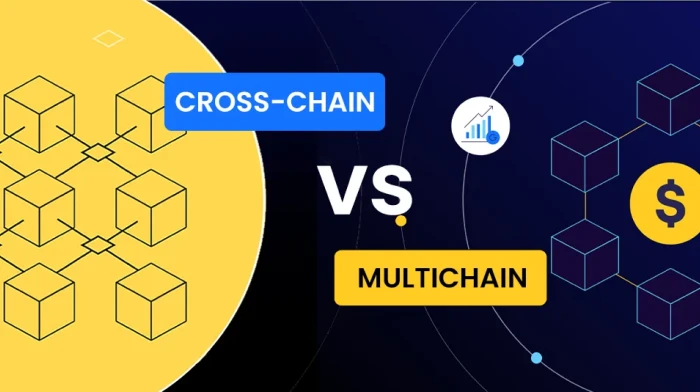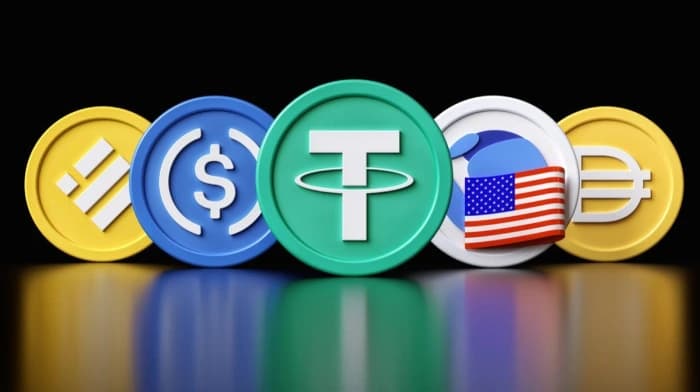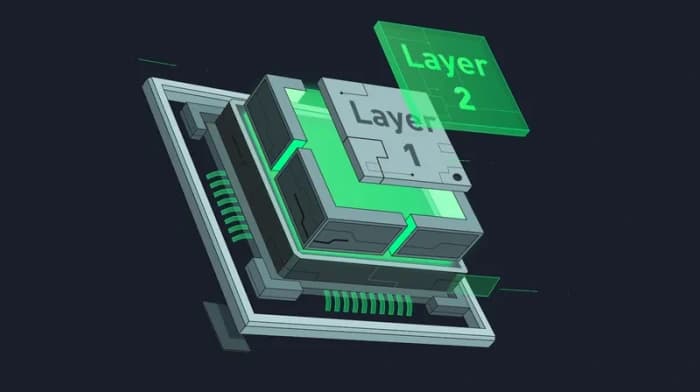
Introduction
Basically it's a system where lots of computers work together to keep a shared record of transactions making it hard for anyone to alter the data without others noticing. This shared record or ledger is what allows for secure and transparent transactions to happen between parties without needing a middleman.
Bitcoin's arrival, in 2009 marked the beginning of an evolution in blockchain technology, which has since given rise to a multitude of platforms and applications built around its features.
Multi-Chain vs Cross-Chain: Understanding the Difference
Terms like "multi chain" and "cross chain" are often tossed around in the breath in cryptocurrency circles. They actually refer to different ideas with unique approaches and outcomes. At their core both concepts do enable the transfer of value and information, between blockchain networks. But that's where the similarities end. The underlying methods and end goals are actually quite different.
As blockchain tech keeps growing the need for blockchain networks to be able to work seamlessly is becoming more and more crucial.
The Importance of Blockchain Interoperability
When different blockchain platforms can talk to each other effortlessly that's what we mean by interoperability. This is crucial because without it blockchain ecosystems can become fragmented which limits the potential of apps and makes it harder for them to be widely adopted.
Having interoperability, between blockchain networks means they can:
- Share information, assets and capabilities
- Open up avenues for innovation and cooperation
- Enable transactions across borders
- Allow assets to be used interchangeably
- Help create ecosystems that work together seamlessly
When different blockchains can work together smoothly it fosters a diverse environment. This in turn leads to a stream of ideas and improvements, in the blockchain world.
What is Multi-Chain Technology?
Multi-chain technology is a way of designing blockchains where several chains are linked together in a unified setup. Each of these chains remains independent but they can still share information with each other in a controlled way.
For this to work the people involved need to be on the same page about how things will be done. They have to agree on rules before they can start exchanging things with each other.
How Multi-Chain Systems Work
In this setup private data stores are kept secure with each network handling its consensus mechanism. When you have blockchains working together things get a bit more complex. For instance each Decentralized Application or DApp has its instance that runs contracts separately, from other applications, on different blockchains.
As the world of blockchain expands across chains the capacity of these networks increases, which in turn lowers the cost of transactions and draws in more users. Each network has its way of dealing with issues like:
- How to scale
- How to stay decentralized
- How to design its basic structure
- How to reach consensus
- How to execute transactions
- How to make data available
- How to protect user privacy
Benefits of Multi-Chain Architecture
One of the advantages of using multi-chains is that it solves some of the core problems that have been holding back blockchain ecosystems. By spreading out across chains these systems can offer a range of benefits that might not be possible within a single chain.
Scalability
When it comes to scalability one of the limitations of single chain blockchain networks is that they can become bogged down. Multi-chain architectures offer a way around this problem.
- By having chains that can process transactions at the same time these platforms can handle a lot more traffic
- This means they can process more transactions per second which is essential for large scale applications
- As a result the network can handle a higher volume of transactions without slowing down
When it comes to managing resources multi-chain architectures have an advantage. They can allocate resources to different chains as needs arise, which helps to get the most out of them and scale easily.
Customization
Multi-chain architectures offer a lot of freedom when it comes to customization. Because each chain can be tailored to fit specific needs or uses they're more versatile than single chain platforms.
With a single chain platform every transaction happens on the same ledger following the same rules. But with multi-chain architectures developers can create chains that are specialized for particular applications.
This ability to customize gives developers a lot of flexibility when designing blockchain solutions. They can create systems that meet the specific needs of different industries and uses rather than trying to fit every application into a one size fits all model.
Developers have the freedom to tailor each chain to a specific purpose by choosing the:
- Consensus mechanism
- Contract language
- Governance model that best suit their needs
This allows them to optimize performance and functionality for specific applications.
Enhanced Security
One major benefit of this multi-chain approach is that it significantly boosts security. By dispersing transactions and smart contracts across chains the potential fallout from security breaches or vulnerabilities is greatly diminished.
Essentially if one chain is compromised the others remain intact thereby preventing a total collapse.
When you're dealing with multiple chains a security breach in one chain doesn't have to mean the others are at risk. That's because a multi-chain setup can have some additional security measures in place.
Multi-Chain Systems Work (Continued)
Security measures across chains include:
- Sharding and encryption across chains
- Multi-signature authentication
- Distribution of transactions and data across chains
- Reduced risk of single point of failure
- Increased network resilience
Real-World Examples of Multi-Chain Platforms
Ethereum 2.0
Some platforms have started using multi-chain architectures to change the way blockchains work. Take Ethereum 2.0 for example. This big upgrade introduces a multi-chain system called the Ethereum Beacon Chain.
The beacon chain is like the main artery of the network overseeing activities across shard chains. Ethereum 2.0 can handle more transactions at once making it faster and more scalable than the original Ethereum blockchain, thanks to something called shard chains that process transactions in parallel.
Polkadot
When it comes to blockchain platforms Polkadot is another example. It's a multi-chain system designed to let different blockchains work together seamlessly.
The platform uses specialized chains known as parachains, which are all connected to a central relay chain. This setup allows parachains to be tailored for specific tasks while the relay chain ensures that all the parachains can communicate with each other in a secure and decentralized way.
Cosmos
Then there's Cosmos, a network made up of different blockchains that can all interact with each other. This allows different blockchain platforms to work together even if they're not identical which can help make the whole blockchain ecosystem more scalable.
The Cosmos Hub is a multi-chain blockchain that brings together a bunch of separate blockchains, known as zones. Each of these zones runs on its own with its own set of:
- Validators
- Ways of reaching consensus
- Systems of governance
Multi-Chain Applications and Use Cases
When you have multiple chains working together like this it opens up a world of possibilities for different kinds of applications. By combining the strengths of each chain you can build systems that are highly scalable tailored to specific needs and more secure.
Decentralized Finance (DeFi)
One area where this is particularly exciting is in decentralized finance or DeFi for short. By using multiple chains DeFi platforms can offer services that are both scalable and highly customizable which is a major step forward for the industry.
Certain financial products like:
- Lending
- Borrowing
- Decentralized exchanges
can be supported by specialized chains. This gives users a wide range of options when it comes to DeFi applications making the whole process more efficient and less expensive.
Supply Chain Management
When it comes to managing supply chains using multiple chains can make a big difference. It makes the whole process more transparent easier to track and more efficient.
With customized chains everyone involved can keep an eye on products as they move through the supply chain. This helps ensure that products are genuine and reduces the risk of counterfeit goods.
Gaming and NFTs
Gaming and non-fungible tokens or NFTs are getting a boost from multi-chain platforms. These platforms make it possible for digital assets to be managed and traded on a larger scale.
A custom chain can be created for a game allowing developers to build engaging experiences with:
- Assets that can be tokenized
- Economies that exist within the game itself
Identity Management
Identity management is another area where multi-chain architectures are making a difference. They provide a secure and decentralized way to manage identities giving individuals control over their personal data and digital presence.
Self-sovereign identity systems are making headway thanks to customized chains that let people keep their identity credentials safe on the blockchain. This gives them complete control over their personal info.
Government and Public Services
In the government and public services sector things are also changing for the better. Multi-chain platforms are bringing transparency and efficiency to data management and governance.
By tailoring chains to their specific needs governments can:
- Move their processes online
- Make public services more accessible
- Be more transparent about what they do
What is Cross-Chain Technology?
Cross-chain technology is a way to move assets and data smoothly between different networks. It works by letting multiple chains connect and work together in a way that's easy to use.
This design makes it possible to:
- Create smart contracts securely
- Move assets between blockchain networks
- Build Decentralized Applications all without needing a central authority to oversee everything
The technology that allows for transactions and applications to span multiple blockchain networks makes it easier to develop programs that can work across chains.
How Cross-Chain Systems Work
With this setup a single instance of a Decentralized Application can run smoothly across smart contracts on separate blockchains rather than having to create separate versions for each network.
In systems that work across blockchain networks different smart contracts on various chains handle specific tasks while staying in sync with each other. They work together to support different uses within a unified application even if the different components are spread out across different networks.
Developers can tap into the advantages of multiple blockchain networks using this approach.
Benefits of Cross-Chain Architecture
One of the main benefits of cross-chain architectures is that they tackle the interoperability issues that are inherent in blockchain ecosystems. By doing this they offer a number of advantages that can improve how different networks connect move assets and reach people.
Enhanced Interoperability
Cross-chain architectures make it possible for different blockchain networks to communicate and interact with each other smoothly. This opens the door to collaboration between networks that were once isolated from one another.
Cross-chain solutions are making it possible to move assets and data between blockchains basically tearing down the walls that separate them. This creates a unified network of systems which helps spread the reach and usefulness of blockchain technology.
Increased Liquidity
One big advantage of this approach is that it increases the amount of assets available for trading. With cross-chain architectures people can transfer and trade assets across multiple blockchains thanks to protocols that allow for smooth interactions between chains.
For example:
- Atomic swaps
- Decentralized exchanges
let people swap assets between different chains without needing any middlemen or centralized exchanges.
Improved Security
This setup also makes things more secure. Since blockchain technology is decentralized and can't be altered cross-chain architectures can take advantage of these features to provide a secure environment.
By allowing assets to be transferred and transactions to take place across chains without needing a middleman cross-chain solutions reduce the risk of dealing with untrustworthy parties and decrease dependence on central authorities.
Risk Diversification
Diversification is another benefit of cross-chain architectures as they give blockchain users access to a wider variety of assets and applications across multiple chains.
This spread reduces the risk of problems in one network affecting the entire operation essentially hedging against failures or weak points in individual blockchains. Users can now use multiple blockchains distributing their risk and protecting themselves from trouble in any one network.
Enhanced Performance
The performance and scalability of cross-chain architectures are also improved by sharing transactions and tasks across several chains. This distributed approach helps to speed things up and make the entire system more efficient.
Distributing workload across multiple networks helps cross-chain solutions tackle congestion and bottlenecks which in turn improves how efficiently things run.
Cross-Chain Technologies and Solutions
When it comes to cross-chain solutions they're all about getting different blockchain networks to work together seamlessly. This opens up a lot of possibilities for moving assets swapping data and making transactions across chains.
Atomic Swaps
Take atomic swaps for example. These allow people to exchange cryptocurrencies with each other without needing some middleman. They can do it all across different blockchains.
This mechanism works without needing to trust the other party allowing users to swap assets in a way that's all or nothing. Either both parties get what they agreed on or the deal is canceled.
Interoperability Protocols
There are several ways that different blockchain networks can talk to each other and share data. For example:
- Interledger Protocol
- Blockchain Interoperability Protocol
are like rules that make sure everything works smoothly when different networks need to communicate. They help set standards so that everything can work together seamlessly.
Decentralized Oracles
Decentralized oracles are like sources of information that blockchain applications can use. They use consensus mechanisms to agree on what the truth is and cryptography to prove it so smart contracts can use data from outside the blockchain itself.
Cross-Chain Bridges
Some protocols and smart contracts are designed specifically to help move assets from one blockchain network to another. They create connections between the networks making it possible to transfer assets safely.
Cross-Chain Platforms
There are also platforms like Chainlink and Wanchain that provide the building blocks and tools for creating applications that can work across blockchain networks. They're like the behind-the-scenes infrastructure that makes cross-chain applications possible.
Cross-Chain Applications and Use Cases
Cross-chain technology is being used in all sorts of ways across different industries.
Decentralized Finance (DeFi)
One of the biggest areas is decentralized finance or DeFi. With cross-chain interoperability it's possible to move assets and provide liquidity across multiple blockchain networks, which is changing the way DeFi works.
Cross-chain asset exchanges are made possible by these platforms giving users the ability to tap into a variety of DeFi protocols and liquidity pools on different chains.
Interoperable Exchanges
When it comes to exchanges that work with multiple blockchains the term "interoperable" is often used. These exchanges rely on protocols and bridges to allow assets to be traded seamlessly even when they're on different blockchain networks.
This means people can buy and sell assets directly without needing a middleman no matter which blockchain the assets are on. These platforms make it possible for people to trade without needing a middleman.
Asset Management
When it comes to managing assets across blockchain networks some platforms make it easy to keep track of your investments and spread them out. This gives users more control and flexibility when it comes to their cryptocurrency portfolios.
NFT Marketplaces
There are also marketplaces where people can buy and sell items like art or collectibles across different blockchain networks. This creates a unified market where people can access and own these unique digital assets.
Supply Chain Management
In the world of supply chains cross-chain technology is helping to make things more transparent and efficient. By allowing data to flow easily between blockchain networks companies can keep track of their goods and supplies and make sure everything is running smoothly.
Multi-Chain vs Cross-Chain: Key Differences
When it comes to blockchains existing within the same ecosystem a key benefit is the ability to facilitate communication between separate blockchain networks. For instance each of these blockchains operates independently which in turn allows for seamless communication between blockchains.
This concept is often referred to as interoperability. It basically means that different chains within the ecosystem can interact with one another enabling both communication and asset transfer between distinct blockchains.
Multi-Chain vs Cross-Chain Comparison
| Aspect | Multi-Chain | Cross-Chain |
|---|---|---|
| Architecture | Multiple chains within same ecosystem | Communication between separate blockchain networks |
| Independence | Each chain operates independently | Blockchains remain separate but interoperable |
| Communication | Internal communication between chains | External communication across different networks |
| Use Cases | Scalability, customization, isolation | Asset transfer, interoperability, liquidity |
| Examples | Ethereum 2.0, Polkadot, Cosmos | Atomic swaps, cross-chain bridges, interoperable DEXs |
Challenges and Future Outlook
The world of blockchain is facing some hurdles particularly when it comes to:
- Security
- Scalability
- Governance
These problems only get more complicated when you're dealing with multiple chains. To top it off there's also the issue of standardizing cross-chain protocols.
The Future of Multi-Chain Technology
Looking ahead both multi-chain and cross-chain technologies have a lot to offer as blockchain continues to evolve. They each have their own path forward and will likely be used in different ways.
One thing that's probably on the horizon for multi-chain ecosystems is that they'll become even more widespread and specialized. As blockchain networks become increasingly complex and diverse there will be a growing need for solutions that are designed to address specific uses.
The way blockchains are built is changing. With multi-chain architectures developers can create blockchains that are specifically designed for certain tasks, which makes them more flexible and able to handle a lot of users.
In the future we might see blockchains connected in a way that allows them to work together smoothly within the same system. This could make it easier for different blockchains to communicate with each other and exchange assets.
The Future of Cross-Chain Technology
The future of blockchains is likely to involve a lot of interaction between chains. This cross-chain technology is going to be key to solving one of the biggest problems in the blockchain world: getting different blockchain systems to work together.
As blockchain networks expand it's becoming really important to be able to move assets and data between chains. The fact is these chains are all separate and that can make it tough to share information or transfer value from one to another.
In the future we can expect to see cross-chain solutions that are more advanced and standardized. This would allow for seamless communication between a bunch of blockchain networks without any hiccups.
Future Outlook (Continued)
We might see protocols and intermediate layers that make transactions between chains not only possible but also trustworthy. If we can get this right it could open up a world of possibilities.
By combining the strengths of different blockchain platforms we could create innovative uses that we haven't even thought of yet.
Conclusion
As blockchain technology continues to develop it's likely that we'll see a shift towards better ways of enabling different blockchains to work together seamlessly. This kind of cross-chain interoperability will probably lead to more cooperation between various projects and communities.
In the end the progress of blockchain is closely tied to how well it can evolve to accommodate both multi-chains and the ability to move between them.
When you bring multiple blockchain ecosystems together they can be really flexible and handle a lot of traffic. But the real power comes from being able to communicate and share assets easily between networks.
As blockchain technology becomes more established combining these approaches will probably lead to some exciting developments in areas like:
- Decentralized finance
- Application development
- And many other innovative use cases
The development of multi-chain and cross-chain technologies is going to have a lasting impact on decentralized tech. This is because these advancements have the potential to improve how different blockchain systems work together.
Multi-chain and cross-chain technologies serve different purposes and solve different problems. Each has its own advantages and which one is best depends on the specific situation.
For companies and developers who want to use blockchain technology it's essential to know the differences between these two approaches. This knowledge will help them make the most of the technology in their projects and applications.


